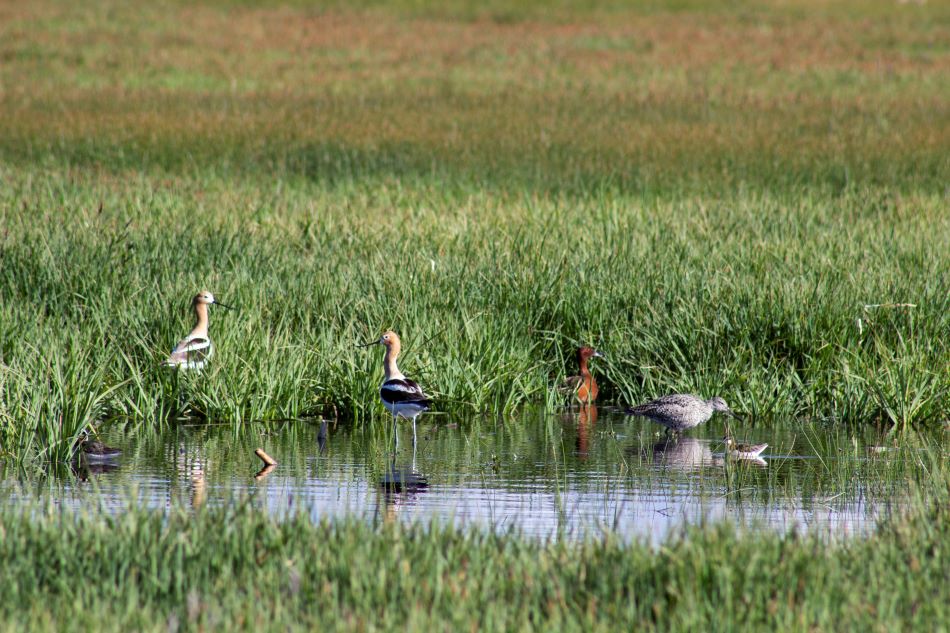Trout Creek Ranch Wet Meadows Bird Surveys
ODLT is seeking bird surveyors to assist coordinators in sunrise point counts May 9-10, June 13-14, July 11-12 in the wet meadows of Trout Creek Ranch Headquarters. These 4-hour wetland surveys will be used to determine overall abundance of migratory birds and are important in guiding restoration plans.
Teresa Wicks from Bird Alliance of Oregon (formerly Portland Audubon) created this protocol, which will be accompanied by audio recording units to capture bird activity as much as possible. Overnight stays are required and we have accommodations for sleeping indoors, outdoors, or vehicle camping (see below and registration form for details).
We’re restoring hundreds of acres of wet meadows at Trout Creek Ranch for sandhill cranes, long-billed curlews, avocets, and other birds in this critical migration and breeding area of the Pacific Flyway. Documenting bird activity will help us understand how we can manage Trout Creek to best benefit the diversity of species that use the creek and associated wet meadows.
The wetlands of Southern Oregon-Northeastern California (SONEC) comprise some of the most important spring and fall staging habitat for waterfowl in North America, supporting more than 70% of the Pacific Flyway’s dabbling ducks in spring migration. Approximately 5,700 acres of Trout Creek Ranch have been identified as SONEC priority areas. Trout Creek Ranch lies 40 miles south of Malheur National Wildlife Refuge, a protected area that supports more than 340 bird species. Like the refuge, we’re planning to manage flood-irrigation, haying, and grazing to provide critical habitat for waterfowl and pronghorn antelope during their migrations, as well as many other animals throughout the year.

Skills and supplies needed/most helpful: Ability to identify regional birds by sight and sound is required and this presentation PDF can help you learn focal species beforehand. Collecting data entails traveling across wetlands, uneven terrain and crossing fences without shade. Routes are typically 5-7 miles roundtrip. There will only be bathroom access at the beginning and end of the route.
A backpack could help carry the necessary pencils and clipboard, along with any insect repellent, mosquito nets, beverages, and snacks. Please bring your preferred food, water, and appropriate clothing for the weather and terrain (waterproof boots, and clothing that can get wet, hiking poles may be helpful). We have a handful of binoculars for use, but you are welcome to use your own or bring a spotting scope.

WHEN:
Surveys take place May 9-10, June 13-14 and July 11-12. Surveys will begin around sunrise and end by 10 AM each morning. In May, we’ll deploy audio recording units and retrieve them in July. Survey start points are a 5-10 minute walk from parking/housing. See overnight stay details below.
Surveys and Overnight Stays
Friday, May 9 3-8 p.m. arrival
Saturday, May 10 sunrise-10 am
Friday, June 13 3-8 p.m. arrival
Saturday, June 14 sunrise-10 am
Friday, July 1 1 3-8 p.m. arrival
Saturday, July 12 sunrise-10 am
Arrival times are flexible between 3-8 p.m. the Friday night before to allow you time to explore the wetlands prior to the survey the following morning. Survey start points are a 5-10 minute walk from parking/housing. See overnight stay details below and in the registration form.
WHERE:
Trout Creek Ranch Headquarters Visitor Info (with detailed directions)
Trout Creek Ranch Headquarters Webpage
Google Maps Directions (About 15 min south of Fields)
WHO
Project Lead: Bandon Palmer, Regional Stewardship Lead
bpalmer@oregondesertlandtrust.org

Learn more from staff & volunteers in an article about our first set of bird surveys in 2024!
Next Steps
If you haven’t already, fill out our two required forms below to participate.
Afterward, we’ll contact you with details. THANKS!
Wildlife Camera Videos
Related Reads
Reaching for new heights in conservation
Together, we can conserve Disaster Peak Ranch!
Going with the flow
We're restoring a creek to help fish and wildlife.
A land of learning
Local Tribal members shared stewardship practices to inspire youth.
Looking out for the birds
Volunteers help guide restoration plans with wetland bird surveys.
Virtual fences mooove cows online
Virtual fence is a new technology that can help land managers maintain wildlife connectivity in permitted grazing areas.
Tribal Gatherings
Tribal leaders discussed the Native history and stewardship of their homelands at Trout Creek Ranch.
Research fueled by fire
Oregon State University finished 10 years of fieldwork on sage-grouse responses to wildfire.
Tribal Stewards
Tribal teens lead on conservation efforts through Northwest Youth Corps.
Spring returns
Rod Klus returns to researching sage-grouse for Oregon Department of Fish and Wildlife.
Mountains of Research
Researchers spent a summer in the mountains and left with more than data.
Spreading wings in conservation
Jack Strang created new connections to the high desert during our first internship.
Neighbors helping neighbors fight fires
Rangeland Fire Protection Associations protect the high desert and each other.

















